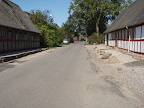This last Wednesday, we packed ourselves up, and instead of going to school, went to Copenhagen. We caught the express train, and in a little over an hour were in Copenhagen. And what a different world that is. Odense is positively provincial in comparison.
We had no plan on what we wanted to see going in. But we had a map, and on that was a walking tour that started at the City Hall plaza and wound through the city to the Little Mermaid. It wound its way back to City Hall and then to Tivoli Gardens, our final destination. The Weather was beautiful - cool, crisp, and clear.
The city hall is marked by the tall clock tower holding an old, but very accurate clock. We missed the trip to the top (it only happens at noon), so we moved along through the streets of the city toward Christiansborg. Aside form being the medieval shoreline of the city, the Christiansborg is the old royal palace as well as the house of the modern-day parliament.
Wandering further, we came to the square called Kongens Nytorv. This is a very upscale area, and in addition to the large mansions, houses the most exclusive hotel in Copenhagen. Right nearby is Nyhavn, a very cute harbor area with brightly painted buildings, old ships, and a lot of cafes. Very nice, and also tourist heaven. We followed Nyhavn out to the main harbor and walked along this for a bit, admiring the old and new architecture mixed together. We also ran across the fire rescue units practicing their rescue diving which was interesting to see.
The next stop was the Ameliaborg, the current Copenhagen residence of the Queen. At noon there is a ceremonial changing of the guard which we saw. Think beefeaters dressed in black instead of red and you are there. We took some photos, saw someone chastised for getting to close to a guard (by the guard), and moved on. Wandering north we arrived at an old stronghold of the city, called the Kastellet. Here there are barracks and a big fortified wall surrounded by a moat. The wall is in the classic star shape of medieval fortresses. The army still controls the area, but except for the barracks the public is allowed to use it as a park.
And north of the Kastellet, we reached our destination: The Little Mermaid. And lunch. I think that lunch was more important. The little mermaid statue in itself is not really a sight. It is a small statue in the harbor. But the walk to it, and back, are the real reasons to go. Heading south we looped past the only Anglican church in Denmark. There is a crazy statue outside of a woman in a chariot being pulled by bulls. More wandering brought us by snack time (supermarkets are very helpful here, and into the Kings garden. A very pleasant park, it houses the Roseonborg Castle as well as the crown jewels.
South of the gardens is the round tower. What a crazy tower it is. It is attached to a church, but unlike other watchtowers it has no stairs. One ascends by walking up a ramp that circles the tower. it is said that Peter the Great rode his horse to the top as he was not fond of walking. Upon our descent we continued through the University district and returned to City Hall square. Wow, what a great city, and what a great day. Ah, but we were only halfway done, because our next destination was Tivoli Gardens. But that is another post.











